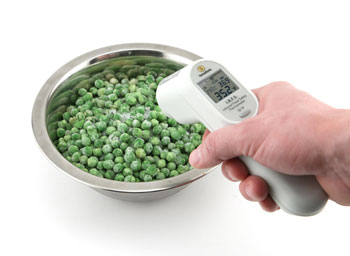Infrared Thermometers in Food Safety Applications
 For years, food safety professionals like, Robert W. Powitz, Ph.D, MPH of the Journal of Environmental Health have had considerable practice in the use and application of infrared thermometers (IR), and have found new environmental health applications for them. As IR's have become refined in size and operation, more food safety trainers and health inspectors are accelerating their use of these devices to speed up and expand the inspection process.
For years, food safety professionals like, Robert W. Powitz, Ph.D, MPH of the Journal of Environmental Health have had considerable practice in the use and application of infrared thermometers (IR), and have found new environmental health applications for them. As IR's have become refined in size and operation, more food safety trainers and health inspectors are accelerating their use of these devices to speed up and expand the inspection process.
As a result, chefs and foodservice managers are compelled to acquire and learn how to more effectively use IR thermometers in their day-to-day operations. Understanding the technical aspects of how temperature is measured and learning the strengths and weakness of infrared thermometers will go a long way to ensure that their food is safe to eat.
First, it's important to note that IR thermometers only measure surface temperatures. Infrareds are not effective at gauging the doneness of foods. When internal temperatures are needed, use a traditional probe thermometer. Fortunately, many infrared thermometers (like the IRK, IR-IND and IR Pro) come with attachable type K thermocouple probes.
Infrared thermometers are vey helpful at performing quick spot checks of hot and cold holding and buffet lines. When using an infrared thermometer with liquids like soups and sauces, pull a ladle full of liquid up from the bottom of the pot before taking a measurement to more closely approximate the internal temperature. To measure semi-solids like stuffing, corn or mashed potatoes, insert a spoon into the center of the material, pull it back to create a void and immediately point your infrared thermometer into the void.
Infrared thermometers used to measure temperatures inside colder climates should be stored (where possible) inside the freezer or walk-in so they are ready to take measurements when you need them. Otherwise, a period of time is needed (up to 30 minutes) to combat the ambient effect that happens as the thermometers lens acclimates to the drastic change in ambient temperature. Immediate temperature taking will result in false readings in thermometers not adjusted to the external temperature.
For cold-climate temperature taking, consider no-lens infrared thermometers like the CZIR and Pocket IR whose lack of a lens allow for immediate use no matter the ambient temperature change.
Once ready to take temperatures inside the freezer or walk-in, be sure to break open pallets being measured and remove at least some of the contents before you attempt to record a reading. You want to make certain your reading reflects the temperature of the frozen material inside the pallet and not just the surfaces that are exposed to warmer air.
Be mindful of emissivity. IR thermometers are typically calibrated on the assumption that they are reading the temperature of "high emissivity" surfaces. That means a surface that efficiently radiates the temperature of an object. Almost all food falls into this category.
Other surfaces, especially highly reflective surfaces such as stainless steal, have low emissivity and act more like a mirror, reflecting the temperature of the surroundings, which are typically closer to room temperature. For example, if you are taking an IR temperature reading of the outside of a stainless steel pot filled with boiling water, you might get a reading of 130°F, rather than a more accurate reading closer to 212°F (boiling point).
Similar situations might occur as you're taking temperatures inside a walk-in cooler with stainless steel walls. The simple solution is to create a high emissivity surface by attaching a piece of masking tape to the reflective area and using that as a measurement target. Also, coating a shiny surface with oil will also give it high emissivity characteristics.
Be aware of "evaporative cooling" effects. If you try to measure the temperature of boiling liquids you're going to get faulty readings caused by evaporating liquid. For more accurate readings, shut off the burner and agitate the surface of the liquid with a fork while you're taking the reading. You're likely to see much more accurate readings than those taken while the liquid was boiling.
Become familiar with your IR thermometers operating range. Consider how you will be using your thermometer before making a purchase. If quick spot-checks of hot holding foods is your main concern (temps between 40-140°F), consider an IR like the IRFS. To measure temperatures above 500°F - for example in a pizza oven - consider an IR with a higher temperature range like the IRK or IRGUN-S.
Finally, become familiar with your instrument's field of view. Some IR thermometers use a laser indicator to help you aim the device. Depending on the thermometer, the laser indicator may sit at the top, bottom, or on the sides of the area being measured. The actual area measured becomes significantly larger as the distance between the thermometer and your target increases. Knowing the distance-to-target ratio (e.g.12:1 found in the IRFS) will allow you to calculate the target area. In most food service applications IR thermometers work best at a distance of 10 inches.
Cited:
Restaurant Hospitality, April 2005. Vol. 89 Number 4. p106
Powitz, Robert W. Ph.D. MPH. Food Safety Magazine, "The Best of the Best: A Critical Look at Basic Inspection Tools." April/May. 2006. www.foodsafetymagazine.com
